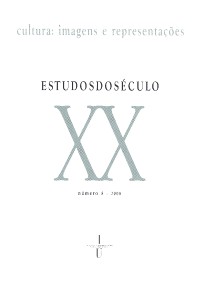Please use this identifier to cite or link to this item:
https://hdl.handle.net/10316.2/36566| Title: | Sobre a visualidade do Brasil Moderno: Causas e combates pelo "retorno à ordem" | Other Titles: | On the visual in modern Brazil: causes and struggles for a "return to order" De la visualité du Brésil moderne: causes et combats en faveur du "retour à l'ordre" |
Authors: | Flores, Maria Bernardete Ramos | Keywords: | modernism;"return to order";racism;sculpture;beauty;modernisme;"retour a l' ordre";racisme;sculpture;beauté;modernismo;"retorno a ordem";racismo;escultura;beleza | Issue Date: | 2008 | Publisher: | Imprensa da Universidade de Coimbra | Abstract: | O artigo abandona o estudo da
relação do modernismo com o
nacionalismo e aborda o percurso
do modernismo brasileiro: a passagem
de seu momento heróico,
antropofágico e desestabilizador,
que experimentava as linguagens
das vanguardas artísticas na pesquisa
e representação da cultura
brasileira, para o chamado "retorno
à ordem"' no seu engajamento
pela reforma e regeneração do
povo brasileiro. A crença no advento
do "homem novo", representada
numa linguagem simbólica esculpida
no corpo atlético, no corpo do
trabalhador e na maternidade, projetava
a imagem de um Brasil
jovem, industrial e moderno, com
filhos saudáveis, belos e fortes. L'article abandonne l'étude de la relation du modernisme avec le nationalisme et aborde le parcours du modernisme brésilien: le passage de son moment historique, anthropophagique et déstabilisateur, qui expérimentait les langages des avant-gardes artistiques dans la recherche et la représentation de la culture brésilienne, pour le dénommé "retour à l'ordre", dans son engagement pour la réforme et la régénération du peuple brésilien. La croyance dans l'avènement de "l'homme nouveau", représentée par un langage symbolique sculptée dans un corps athlétique, dans le corps du travailleur et dans la maternité, projetait l'image d'un Brésil jeune, industriel et moderne, avec des enfants sains, beaux et forts. This article abandons the study of the relationship between modernism and nationalism to look at the course of Brazilian modernism: the passing of its heroic, anthropophagic and destabilising moment that experimented with the discourse of the artistic vanguard in the search and representation of Brazilian culture, to the so-called "return to order" in its engagement with reform and the regeneration of the Brazilian people. Represented in a symbolic language sculpted into the athletic body, the body of the worker and motherhood, the belief in the advent of the "new man'' projected the image of a young, industrial and modern Brazil, with healthy, beautiful, strong children. |
URI: | https://hdl.handle.net/10316.2/36566 | ISSN: | 1645-3530 1647-8622 (digital) |
DOI: | 10.14195/1647-8622_8_3 |
| Appears in Collections: | Revista Estudos do Século XX |
Files in This Item:
| File | Description | Size | Format | |
|---|---|---|---|---|
| sobre_a_visualidade_do_brasil_moderno_causas_e_combates_pelo_retorno_a_ordem.pdf | 1.8 MB | Adobe PDF |  |
Items in DSpace are protected by copyright, with all rights reserved, unless otherwise indicated.
